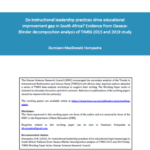Do instructional leadership practices drive educational improvement gap in South Africa? Evidence from Oaxaca-Blinder decomposition analysis of TIMSS 2015 and 2019 study

Quality school leadership and management is an important determinant of quality teaching and learning, especially in low-resourced schools. According to South Africa’s national development plan (NDP), principals should provide both administrative and curriculum leadership at schools. This paper investigates the improvement between 2015 and 2019 Grade 9 mathematics scores in South Africa and explores the extent to which the difference in performance can be related to instructional leadership practices among schools. Using the Oaxaca-Blinder (OB) decomposition technique, the performance gap has been decomposed into the part that can be explained by difference in endowments of educational inputs, such as student, teacher and school/principal characteristics, and the part that is due to the returns to the educational inputs invested, which could be related to a factor such as school discipline. It was found that the TIMSS improvement in mathematics achievement was largely explained by the efficiency of the educational inputs, including those related to instructional leadership. Findings also revealed that instructional leadership variables were not instrumental in determining improvement in low-resourced schools. This means that there are other important factors that are working in the general schooling system, and policy should focus on low-resourced schools to assist them in anchoring instructional leadership practices.
